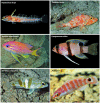Below the Mesophotic
- PMID: 29559694
- PMCID: PMC5861108
- DOI: 10.1038/s41598-018-23067-1
Below the Mesophotic
Abstract
Mesophotic coral ecosystems, which occur at depths of ~40 to 150 m, have received recent scientific attention as potential refugia for organisms inhabiting deteriorating shallow reefs. These ecosystems merit research in their own right, as they harbor both depth-generalist species and a distinctive reef-fish fauna. Reef ecosystems just below the mesophotic are globally underexplored, and the scant recent literature that mentions them often suggests that mesophotic ecosystems transition directly into those of the deep sea. Through submersible-based surveys in the Caribbean Sea, we amassed the most extensive database to date on reef-fish diversity between ~40 and 309 m at any single tropical location. Our data reveal a unique reef-fish assemblage living between ~130 and 309 m that, while taxonomically distinct from shallower faunas, shares strong evolutionary affinities with them. Lacking an existing name for this reef-faunal zone immediately below the mesophotic but above the deep aphotic, we propose "rariphotic." Together with the "altiphotic," proposed here for the shallowest reef-faunal zone, and the mesophotic, the rariphotic is part of a depth continuum of discrete faunal zones of tropical reef fishes, and perhaps of reef ecosystems in general, all of which warrant further study in light of global declines of shallow reefs.
Conflict of interest statement
The authors declare no competing interests.
Figures







References
-
- Bongaerts P, Ridgway T, Sampayo EM, Hoegh-Guldberg O. Assessing the ‘deep reef refugia’ hypothesis: focus on Caribbean reefs. Coral Reefs. 2010;14:309–327. doi: 10.1007/s00338-009-0581-x. - DOI
-
- Hinderstein LM, et al. Mesophotic coral ecosystems: characterization, ecology, and management. Coral Reefs. 2010;29:247–251. doi: 10.1007/s00338-010-0614-5. - DOI
-
- Bejarano I, Appeldoorn RS, Nemeth M. Fishes associated with mesophotic coral ecosystems in La Parguera, Puerto Rico. Coral Reefs. 2014;33:313–328. doi: 10.1007/s00338-014-1125-6. - DOI
-
- Kahng SE, Copus JM, Wagner D. Recent advances in the ecology of mesophotic coral ecosystems (MCEs) Environmental Sustainability. 2014;7:72–81.
Publication types
MeSH terms
LinkOut - more resources
Full Text Sources
Other Literature Sources

